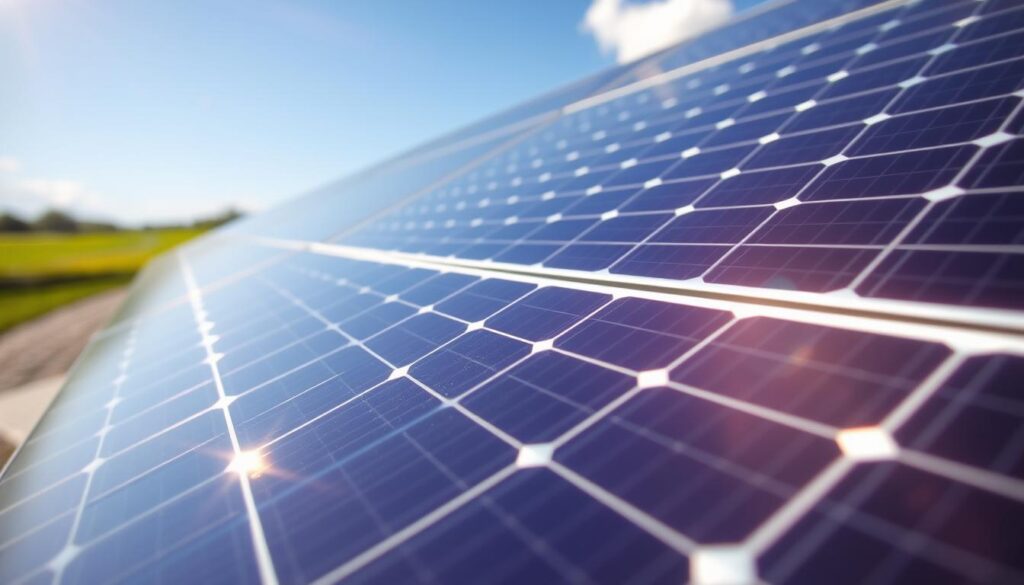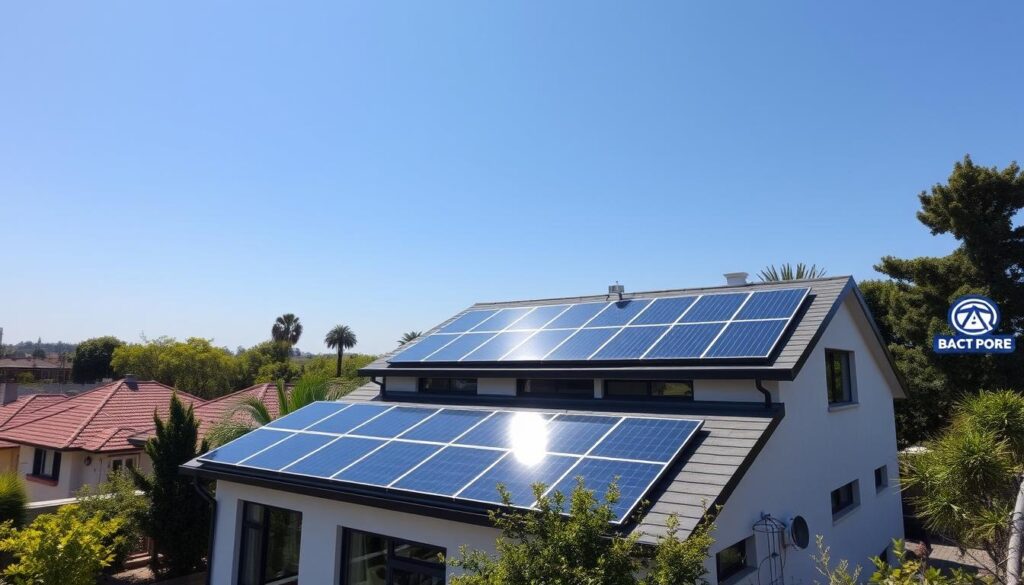Clean Power Explained
Solar energy comes from the sun’s rays and can be turned into electricity or heat. It’s a clean, renewable, and sustainable way to power our world. This article will cover the basics of solar energy, how it’s captured, its benefits, and its promising future.

Key Takeaways
- Solar energy is a clean, renewable, and sustainable power source derived from the sun’s radiation.
- Solar power can be converted into electricity or heat through various technologies, such as photovoltaic cells and solar thermal systems.
- Solar energy offers numerous benefits, including reduced carbon footprint, energy independence, and cost savings.
- Advancements in solar technology and increasing affordability are driving the growth of solar power usage in both residential and commercial applications.
- The future of solar energy looks bright, with continued innovation and increased accessibility poised to make it a dominant player in the global energy landscape.
What is Solar Energy?
Solar energy comes from the sun. The sun’s rays, or sunlight, are made in the sun’s core. These rays reach Earth as visible light, ultraviolet, and infrared.
Understanding the Basics of Sunlight
The sun is a huge energy source. It sends out solar radiation in waves. These waves travel fast, reaching Earth and giving us light and warmth.
Harnessing Solar Radiation for Power Generation
Solar energy technologies turn solar radiation into energy we can use. This is done with photovoltaic cells or solar panels. Cells make electricity, while panels heat water or steam.
“Solar energy is the cleanest and most abundant renewable energy source available, and we can use it to power our homes, businesses, and even entire communities.”
Turning solar radiation into energy is key in the solar energy field. It’s vital for our move to sustainable, green power.
Types of Solar Energy Technologies
Solar power is a top choice for renewable energy, offering a clean and sustainable way to meet our energy needs. There are two main types: photovoltaic (PV) solar cells and solar thermal systems.
Photovoltaic (PV) Solar Cells
Photovoltaic solar cells are the most popular and widely used. They turn sunlight directly into electricity through the photovoltaic effect. This process uses sunlight’s energy to create an electric current. This current can power homes, businesses, and even the electrical grid.
Solar Thermal Systems
Solar thermal systems work differently. They use the sun’s heat to make steam, which then powers turbines to make electricity. They can also be used for heating water or keeping buildings warm.
Both PV cells and solar thermal systems are key to solar power’s growth. As we look for cleaner energy, these technologies will play a big role in our energy future.

Benefits of Solar Energy
Solar power is a key part of moving towards a greener future. It uses the sun’s clean energy, reducing our need for dirty fossil fuels. This helps lower our carbon footprint and fights climate change.
Solar energy is great for the environment. It makes electricity without pollution, unlike other energy sources. Plus, the sun is everywhere, and solar tech is getting cheaper. This makes solar power a good choice for homes and businesses.
Reduced Carbon Footprint
Switching to solar energy cuts down our carbon footprint. It makes electricity without greenhouse gases. This helps protect our planet from energy pollution.
Cost-Effectiveness and Accessibility
Solar energy is getting cheaper and more common. This makes it easier for people and businesses to use. More folks can now enjoy the perks of renewable energy.
| Benefit | Description |
|---|---|
| Renewable and Sustainable | Solar energy is a renewable resource that can be harnessed indefinitely, unlike fossil fuels. |
| Clean and Eco-Friendly | Solar power generation does not produce any emissions or air pollution, making it a clean energy solution. |
| Cost-Effective | The cost of solar technology has decreased significantly, making it a more affordable energy option. |
| Accessible | The increasing availability and adoption of solar power make it accessible to a wider range of consumers. |
“The sun, the moon, and the stars would have disappeared long ago… had they happened to be within the reach of predatory human hands.” – Henry David Thoreau
The world is looking for better energy options, and solar power is a top choice. It lets us use the sun’s energy for a cleaner future. This way, we all help make our planet greener.
Residential and Commercial Solar Applications
The world is moving towards renewable energy, and solar power is leading the way. It’s used in homes and businesses alike. Solar energy comes in many forms, from small rooftop panels to huge solar farms.
Rooftop Solar Panels
More people and businesses are choosing rooftop solar panels. These panels turn sunlight into electricity, making homes and businesses more energy-independent. They save money in the long run and help the environment.
Solar Farms and Utility-Scale Projects
Solar farms and utility-scale solar projects are big players in renewable energy. They’re built in sunny areas to make lots of electricity. This electricity powers whole communities, helping us move towards a greener future.

“The growth of solar energy is a testament to its ability to provide clean, affordable, and accessible power for people and communities around the world.”
The need for renewable energy keeps growing. So, both rooftop solar panels and utility-scale solar projects are key to a sustainable energy future.
Solar Energy and the Environment
Solar power is a clean and renewable energy source. It plays a key role in reducing our carbon footprint and creating a sustainable future. By switching to solar energy, we can greatly cut down on greenhouse gas emissions. This helps a lot in fighting climate change.
Reducing Carbon Footprint
Solar energy is great for lowering our carbon emissions. It’s different from fossil fuels, which pollute and harm the environment. Solar power is clean and doesn’t add to these problems. By using solar energy, we can make our environment healthier and more sustainable.
Also, solar energy has a low environmental impact. Making and installing solar panels doesn’t waste much or use many resources. This makes solar energy a clean and eco-friendly choice for our energy needs.
“The transition to clean energy is not only good for the planet, but it also presents significant economic opportunities. Investing in solar power can create jobs, stimulate local economies, and pave the way for a more sustainable future.”
As we face the challenge of climate change, solar energy is key. It helps us reduce our carbon footprint and make the world cleaner and more sustainable. By using the sun’s power, we can help create a better future for all.
The Future of Solar Power
The world is moving towards a greener energy future, and solar power is leading the way. New solar technology is making solar cells more efficient. At the same time, solar power is getting cheaper, making it easier for more people to use it.
Advancements in Solar Technology
Scientists and inventors are always looking for new ways to improve solar energy. They’re working on better materials and designs. This includes high-efficiency solar cells and ways to store energy, making solar power more reliable and flexible.
Increasing Affordability and Accessibility
The cost of solar power is going down fast. This is because making solar panels is getting cheaper and more efficient. Now, more people can afford to use solar power, thanks to lower prices and help from government programs.
“The future of solar power is bright, with ongoing advancements in technology and a steady decline in the cost of installations. Solar is becoming an increasingly accessible and affordable option for households, businesses, and communities around the world.”
The world faces big challenges like climate change, but solar power offers hope. With better solar technology and lower costs, we’re moving towards a cleaner energy future. This change is already happening, thanks to solar power’s growing popularity.
Conclusion
Solar energy is a clean, renewable, and sustainable power source. It’s key to our energy future. By learning about solar power, its technologies, and benefits, we see its huge potential.
As renewable energy gets cheaper and easier to use, it will power our homes and businesses. Switching to solar power and clean energy is smart and essential. It helps protect our planet and ensures a green future for all.
The growth in solar tech, lower costs, and easier access to solar energy systems are good signs. They show our energy future is bright. By using solar energy, we can create a greener, more sustainable world, powered by the sun.
FAQ
What is solar energy?
Solar energy comes from the sun’s rays and is turned into electricity or heat. It’s clean, renewable, and key for our planet’s power.
How does solar energy work?
Solar energy captures sunlight and changes it into electricity or heat. This is done with photovoltaic (PV) solar cells and solar thermal systems.
What are the different types of solar energy technologies?
There are two main types: photovoltaic (PV) solar cells and solar thermal systems. PV cells turn sunlight into electricity. Solar thermal systems use sun heat to make steam, which powers turbines.
What are the benefits of solar energy?
Solar energy is clean, renewable, and cuts down on fossil fuel use. It also reduces carbon emissions and air pollution. Plus, it’s getting cheaper, making it a good choice for homes and businesses.
How is solar energy being used in residential and commercial applications?
Solar energy is used in many ways. Rooftop panels let homes and businesses make their own electricity. Big solar farms also power entire cities.
How does solar energy impact the environment?
Solar energy is great for the environment. It’s clean and cuts down on greenhouse gas emissions. Using solar energy helps fight climate change and makes our future greener.
What is the future of solar power?
Solar power’s future is very promising. New tech and lower costs are making it more accessible. More people and places are using solar energy, thanks to its growing affordability and efficiency.










thank you
You are Welcome!